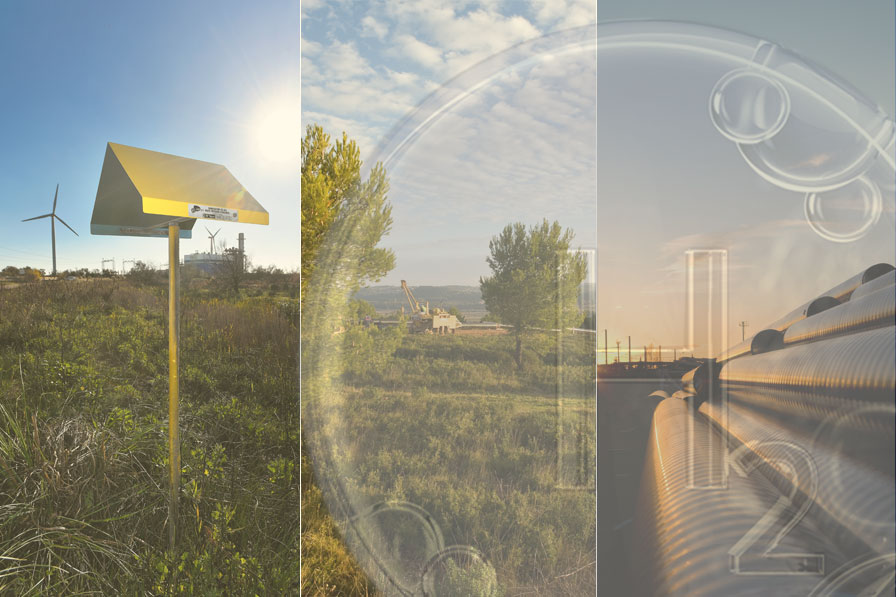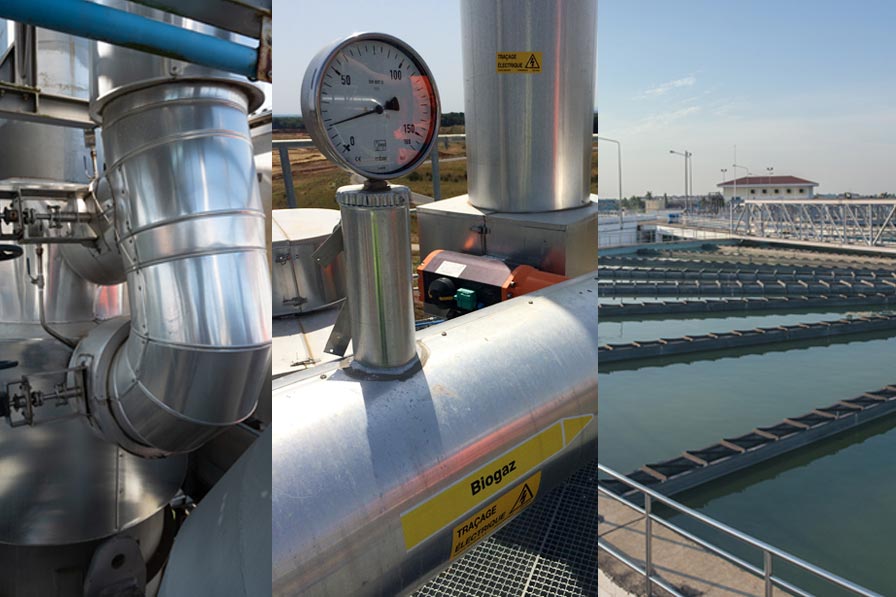Hydrogen

With its ability to store renewable energies, hydrogen offers a decarbonisation solution that complements renewable gases. The development of low-carbon and renewable hydrogen is a priority for France and Europe alike. It is also a priority for GRTgaz, which is fully committed to meeting this challenge.
Understanding hydrogen, an accelerator of the energy transition
Like electricity, hydrogen is an energy carrier which can be used to transport energy from one point to another. Although this gas exists in great abundance in the universe in general, it is very rare on Earth in its natural state. However, it is found in large quantities in combination with other elements:
- In water, which is made up of two hydrogen atoms and one oxygen atom (H2O),
- In methane, which is made up of four hydrogen atoms and one carbon atom (CH4),
- In hydrocarbons,
- In all living organisms, plants and animals.
Hydrogen is extracted from water, methane, hydrocarbons or biomass using chemical processes that separate the hydrogen atoms from other atoms. Several production methods exist, including steam reforming of natural gas, coal gasification and steam cracking of hydrocarbons. Hydrogen produced from fossil fuels is known as “grey” hydrogen.
The challenge today is to replace “grey” hydrogen with renewable and low-carbon “green” hydrogen. Water electrolysis is a promising technology in this respect. It consists of producing hydrogen by separating hydrogen atoms from water under the action of an electric current. We talk of low-carbon hydrogen if the electricity used comes from low-carbon sources such as nuclear power. Hydrogen is said to be renewable if the electricity comes from renewable energies.
Hydrogen is a gas that offers many advantages for the energy transition, decarbonisation and improving air quality. Using hydrogen avoids emissions of greenhouse gases and atmospheric pollutants (particles, NOx, etc.). Its carbon footprint is also very favourable if it is produced from low-carbon or renewable resources.
Hydrogen is also emerging as a solution for the future to mitigate the intermittent nature of renewable energies and make full use of their production capacity. Power to Gas enables surplus renewable electricity to be transformed into hydrogen by electrolysis of water, and stored. The hydrogen can then be injected directly into a dedicated transport network and used to reduce carbon emissions in industry and mobility.
By offering an alternative to fossil hydrogen, low-carbon and renewable hydrogen produced in France is finally helping to ensure the country’s energy sovereignty.
"With its numerous energy and environmental advantages, hydrogen contributes, alongside other renewable gas sectors, to accelerating the energy transition. GRTgaz mobilizes its skills to build a dedicated transport network, and thus contribute to the creation of a future energy mix that is safe, affordable and climate-neutral."
Jana Kavicka, H2 Business Developer
Hydrogen has long been used in the oil and chemical industries to manufacture ammonia and fertilisers, and to refine petroleum products. More recently, it has been used in the steel industry to produce steel. Around 900,000 tonnes of hydrogen per year, or 35.5 TWh/year, are currently consumed in France. However, 96% of this hydrogen comes from fossil fuels. The successful replacement of grey hydrogen with green hydrogen in industrial processes is one of the keys to accomplishing the energy transition and decarbonisation.
Hydrogen is also a solution for decarbonising heavy mobility.
Experiments are underway in the shipping industry, with the launch of the first ships to run on e-methanol or e-ammonia – fuels produced using hydrogen – set to take place in 2025.
Hydrogen is also proving to be a promising fuel for the aviation industry, although the question of the storage volumes needed to integrate it into the aircraft is dampening technological momentum.
The deployment of an efficient transport network is a strategic factor in the development of hydrogen and the creation of an organised market. The challenge is to guarantee the security and flexibility of supply by transporting hydrogen at a competitive cost. This requires appropriate uniform and interconnected services to meet local, national and, by extension, European needs.
For several years now, GRTgaz has been working to develop the future hydrogen transport network in France. The company organises and supports numerous projects and initiatives aimed at designing robust transport infrastructures with open, non-discriminatory access.
What is the current state of the hydrogen market in France and Europe?
Low-carbon and renewable hydrogen, a source of energy with high priority for France
In France, low-carbon and renewable hydrogen has been asserted as a priority lever for achieving carbon neutrality by 2050. Alongside renewable gases and electricity, it is one of the pillars of France’s future energy mix.
In 2018, France was one of the first countries to adopt a Hydrogen Plan. This was supplemented in 2020 by the National Hydrogen Strategy. The France 2030 investment plan has earmarked nine billion euros to support the development of a competitive, low-carbon, renewable hydrogen electrolysis industry.
The National Hydrogen Strategy sets out a gradual development path which GRTgaz is supporting as an expert in gas transmission. The priority is to roll out a complete local hydrogen production, transportation and consumption chain in the industrial regions that consume the most hydrogen. The second stage will involve developing the network on a large scale to establish an organised hydrogen market.
France’s 2030 targets for the development of decarbonised hydrogen:
- In industry and new uses: achieve a decarbonised hydrogen production target of 700,000 tonnes (or 27.6 TWh) out of a total hydrogen production of 1,345,000 tonnes, i.e. increase the decarbonised hydrogen production capacity from 5% to 52%.
- Cover 30% of industrial uses with decarbonised hydrogen, compared to 5% in 2022.
- In the mobility sector: aim for 342,000 tonnes (13.5 TWh/year) of decarbonised hydrogen, with 300,000 light hydrogen vehicles, 5,000 heavy-duty vehicles, 1,000 ships, 250 trains and 1,000 charging stations.
Towards a future European hydrogen transport network: the European Hydrogen Backbone initiative
The hydrogen dynamic has been launched in France and throughout Europe. As part of the Green Deal and the plan RePowerEU, Europe has set a target to produce 10 million tonnes (394 TWh) of renewable hydrogen in the EU and to import a further 10 million tonnes by 2030.
European gas infrastructure operators are joining forces to develop hydrogen in line with this European Union strategy. GRTgaz is working on the creation of the European Hydrogen Backbone » – EHB. The aim of this initiative is to develop a European infrastructure as part of a cross-border cooperation to ensure the security of supply for customers and create a market that encourages competition.
The EHB initiative plans to roll out a 53,000 km hydrogen network linking 28 European countries together by 2040. The aim is to close the gaps between national differences in supply and demand, and to provide access to an abundant, low-cost supply of hydrogen. In June 2022, the managers of infrastructure operators said that they were ready to build the first hydrogen supply corridors by 2030, with interfaces to external exporting countries.
The project involves converting existing gas transmission pipelines and building new infrastructures.
The challenges involved in building the European hydrogen network
In June 2022, the conditions for the successful development of hydrogen in Europe were set out by the European energy infrastructure operators within the EHB:
- Development of a stable and harmonised European regulatory framework: regarding this point, the delegated acts adopted in 2023 by the European Commission have removed the initial uncertainties, by providing a clear definition of the conditions under which hydrogen can be considered renewable.
- Coordination of national policies: this would improve the coordination of cross-border projects, which are currently slowed down by planning and permitting procedures that are often long and complex and differ from one country to the next.
- Unlocking financing to fast-track hydrogen infrastructure deployment by applying regional regulatory flexibility and other pragmatic financing solutions (including incentivising the adoption of hydrogen by demand sectors).
- Diversification of hydrogen sources: the EHB underlines the importance of intensifying energy partnerships with hydrogen-exporting countries. This means securing supply through a common certification system to ensure that producers respect the European Union framework and the renewable origin of the hydrogen.
- Facilitating integrated energy system planning for hydrogen, natural gas and electricity infrastructures.
H2Med project, the first large-scale cross-border hydrogen transport corridor
The H2Med project is the first large-scale green corridor that will connect the Iberian Peninsula with north-west Europe, allowing renewable hydrogen to be transported from production areas to higher consumption areas particularly through the associated national hydrogen infrastructures. This is an example of European energy cooperation organised by the various European transmission system operators: French (GRTgaz and Teréga), German (OGE), Spanish (Enagás) and Portuguese (REN) operators.
“H2Med is an historic initiative. It is the first green hydrogen corridor project to unite several European nations. It embodies Europe’s commitment to establishing a robust hydrogen market aimed at decarbonising both industry and mobility within the continent while ensuring a reliable domestic supply.”Thierry Trouvé
Chief Executive Officer of GRTgaz

